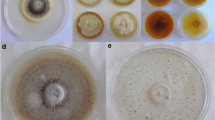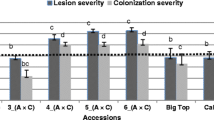Abstract
Brown spot of pear (BSP), a fungal disease, was recently detected in the Alto Valle of Río Negro region in Patagonia, Argentina. BSP is caused by Stemphylium vesicarium (teleomorph: Pleospora herbarum, syn. P. allii) in its sexual and asexual stages, and its main symptoms are lesions in fruit and leaves. The aim of the present study was to characterize the susceptibility of four main pear cultivars grown in the Alto Valle of Río Negro to infection by S. vesicarium. Over four recent growing seasons, BSP incidence and severity were monitored in an orchard with ‘Williams’, ‘Packham’s’, ‘D'Anjou’, and ‘Abate Fetel’ pear cultivars. In addition, inoculations of a pathogenic S. vesicarium strain were performed on detached fruit and leaves of the four cultivars. Both in-field observations and in vitro inoculation experiments indicated that fruit and leaf susceptibility to BSP was markedly higher in ‘D'Anjou’ and ‘Abate Fetel’ compared to ‘Packham’s’ and ‘Williams’. These findings provide valuable information for the correct allocation of resources to efficiently monitor and control BSP.





Similar content being viewed by others
Data Availability
The data that support the findings of this study are available from the corresponding author upon reasonable request.
References
Blancard D, Allard E, Brest P (1989) La Stemphyliose du poirier ou “macules brunes”. Phytoma 406:37–38
Cavanni P, Ponti I (1994) Maculatura bruna del pero: una micopatia sempre d’attualità. Riv Frutic 12:37–42
Cribari-Neto F, Zeileis A (2010) Beta Regression in R. J Stat Softw. https://doi.org/10.18637/jss.v034.i02
Di Masi S (2017) La mancha negra del peral afecta la región. Diario Río Negro. http://www.rionegro.com.ar/la-mancha-negra-del-peral-afecta-la-region-YG2293441
Dobra AC, Garcia L (2015) Presencia de mancha negra del peral, Stemphylium vesicarium, en el Valle Medio del Río Negro, Patagonia Argentina. XXXVIII Congreso Argent Hortic Bahía Blanca Buenos Aires 34(85):73
Fox J, Weisberg S (2019) An R Companion to Applied Regression, 3rd Edition. Thousand Oaks, CA. https://socialsciences.mcmaster.ca/jfox/Books/Companion/index.html
Köhl J, Groenenboom-de Haas BH, Kastelein P, Rossi V, Waalwijk C (2009) Quantitative detection of pear-pathogenic Stemphylium vesicarium in orchards. Phytopathology 99(12):1377–1386
Lenth RV (2021) Emmeans: estimated marginal means, aka least-squares means. R Package Vers 1(6):2–1
Llorente I, Montesinos E (2004) Development and field evaluation of a model to estimate the maturity of pseudothecia of Pleospora allii on pear. Plant Dis. https://doi.org/10.1094/PDIS.2004.88.2.215
Llorente I, Montesinos E (2006) Brown spot of pear: an emerging disease of economic importance in Europe. Plant Dis 90(11):1368–1375. https://doi.org/10.1094/PD-90-1368
Llorente I, Moragrega C, Ruz L, Montesinos E (2012) An update on control of Brown spot of pear. Trees 26:239–245. https://doi.org/10.1007/s00468-011-0607-1
Lüdecke D, Ben-Shachar MS, Patil I, Waggoner P, Makowski D (2021) performance: an R package for assessment, comparison and testing of statistical models. J Open Sour Softw 6(60):3139. https://doi.org/10.21105/joss.03139
Ministerio de Hacienda y Finanzas Públicas, Presidencia de la Nación (2016) Informes de cadena de valor frutícola, manzana y pera. https://www.argentina.gob.ar/sites/default/files/complejo_fruta_pepita.pdf
Montesinos E, Moragrega C, Llorente I, Vilardell P (1995) Susceptibility of selected European pear cultivars to infection by Stemphylium vesicarium and influence of leaf and fruit age. Plant Dis 79(5):471–473. https://doi.org/10.1094/PD-79-0471
Montesinos E, Vilardell P (1992) Evaluation of FAST as a forecasting system for scheduling fungicide sprays for control of Stemphyllium vesicarium on pear. Plant Dis 76:1221–1226. https://doi.org/10.1094/PD-76-1221
Namesny Vallespir A (2001) Panorama mundial en producción de peras. https://www.interempresas.net/Horticola/Articulos/66918-Panorama-mundial-en-produccion-de-peras.html
Polfliet M (2002) Aantasting Stemphylium neemt met het jaar toe [Infection of Stemphylium increases every year]. Fruitteelt 92(20):16–17
R Core Team (2021) R: a language and environment for statistical computing. R Foundation for Statistical Computing, Vienna, Austria
R Studio Team (2020) R Studio: Integrated development for R. R Studio, PBC, Boston, MA
Regional Program of Maturity (2019) Fechas Tentativas de Cosecha, Temporada 2019–2020. https://inta.gob.ar/sites/default/files/fechas_tentativas_de_cosecha_2019-2020.pdf
Rodríguez AB, Muñoz AR (2022). Variabilidad agroclimática en el Alto Valle de Río Negro y Neuquén. Análisis de los últimos 50 años. INTA Ediciones. Centro Regional Patagonia Norte.
Schneider CA, Rasband WS, Eliceiri KW (2012) NIH image to imagej: 25 years of image analysis. Nat Methods 9(7):671–675. https://doi.org/10.1038/nmeth.2089
Tanahashi M, Minoguchi C, Yokoyama K, Otani H (2008) The first report of brown spot of European pear caused by Stemphylium sp. in Niigata prefecture Japan. Japan J Phytopathol 74(183)
Tanahashi M, Okuda S, Miyazaki E, Parada R, Ishihara A, Otani H, Osaki-Oka K (2017) Production of host-selective SV-toxins by Stemphylium sp. causing Brown Spot of European Pear in Japan. J Phytopathol 165:189–194. https://doi.org/10.1111/jph.12549
Temperini CV, Tudela MAA, Giménez GN, Di Masi SN, Pardo AG, Pose GN (2022) Brown spot of pear, an emerging disease in Argentina: identification and pathogenicity characterization of Argentinean Stemphylium vesicarium isolates. Eur J Plant Pathol. https://doi.org/10.1007/s10658-022-02493-y
Toranzo J (2016) Producción mundial de manzanas y peras. Ediciones INTA, Digital book, PDF. ISBN 978-987-521-696-9. https://inta.gob.ar/sites/default/files/inta_produccion-mundial-de-manzanas-y-peras_0.pdf
Tudela MAA, Di Masi SN, Pose GN (2021) Evolución de las estructuras invernantes de Pleospora herbarum, fase sexual de Stemphylium vesicarium, en perales del Alto Valle de Río Negro, Argentina. V Congreso Argentino de Fitopatología. https://drive.google.com/file/d/1J8OmiWSCjgd13-MQfTtTxK7U85nijiaO/view
Vilardell P (1988) Stemphylium vesicarium en plantaciones de peral. Fruticult Profes 18:51–55
Wickham H (2016) ggplot2: Elegant graphics for data analysis. Springer-Verlag, New York, p 2016
Acknowledgements
This work was supported by the Instituto Nacional de Tecnología Agropecuaria (INTA) and Consejo Nacional de Investigaciones Científicas y Técnicas (CONICET).
Funding
This work was supported by Instituto Nacional de Tecnología Agropecuaria (INTA) and Consejo Nacional de Investigaciones Científicas y Técnicas (CONICET).
Author information
Authors and Affiliations
Corresponding author
Ethics declarations
Conflict of interest
The authors declare that they have no known competing financial interests or personal relationships that could have appeared to influence the work reported in this paper.
Ethical approval
All authors are fully aware of this submission and have declared that they have no competing interests. The results presented in this manuscript did not involve any protected and/or endangered species, human participants, nor specimens or tissue samples from vertebrate animals, embryos, or tissues.
Additional information
Publisher's Note
Springer Nature remains neutral with regard to jurisdictional claims in published maps and institutional affiliations.
Rights and permissions
Springer Nature or its licensor (e.g. a society or other partner) holds exclusive rights to this article under a publishing agreement with the author(s) or other rightsholder(s); author self-archiving of the accepted manuscript version of this article is solely governed by the terms of such publishing agreement and applicable law.
About this article
Cite this article
Tudela, M.A.A., Gimenez, G.N., Di Masi, S.N. et al. Susceptibility of South American pear cultivars to brown spot of pear caused by Stemphylium vesicarium. J Plant Dis Prot 130, 1347–1356 (2023). https://doi.org/10.1007/s41348-023-00783-z
Received:
Accepted:
Published:
Issue Date:
DOI: https://doi.org/10.1007/s41348-023-00783-z




